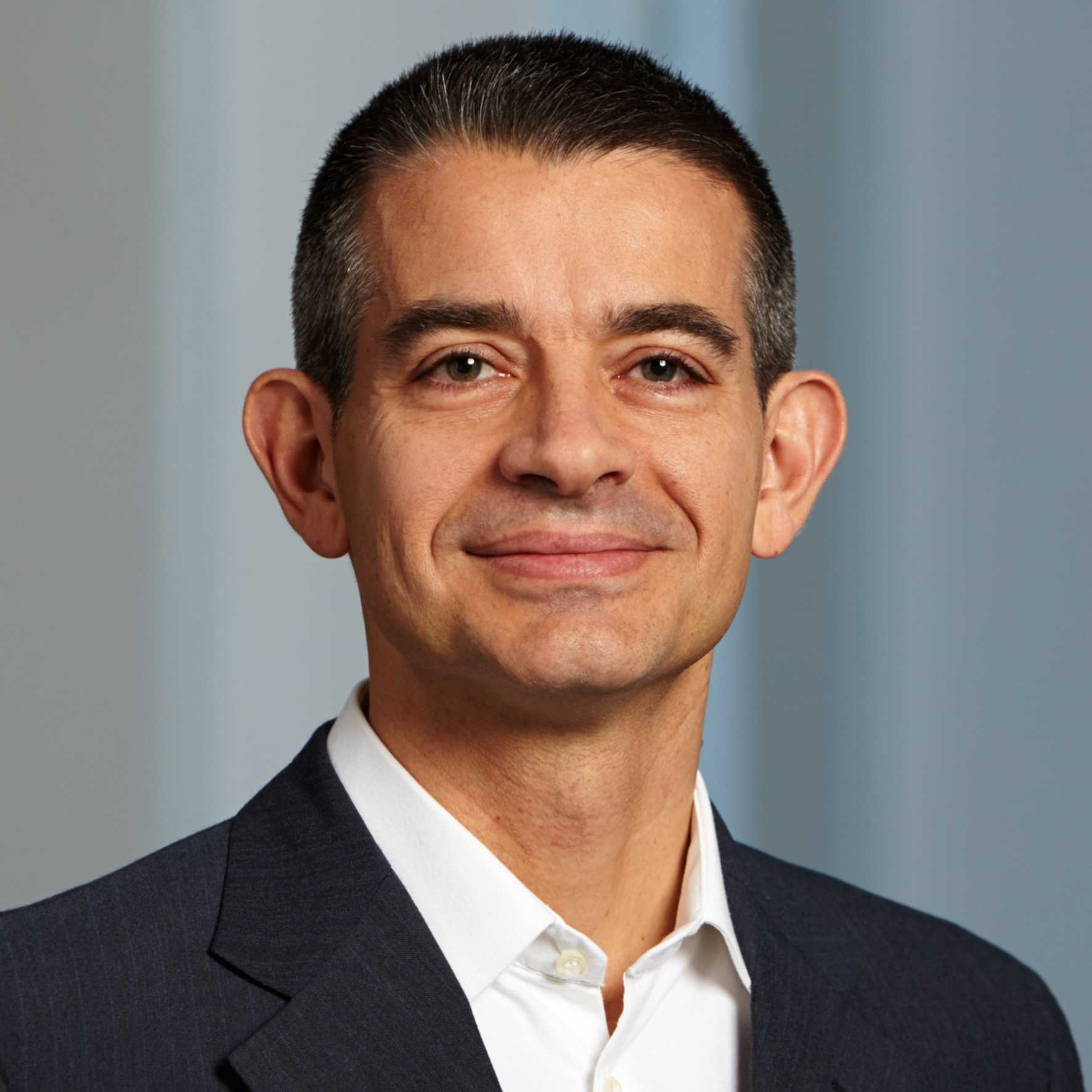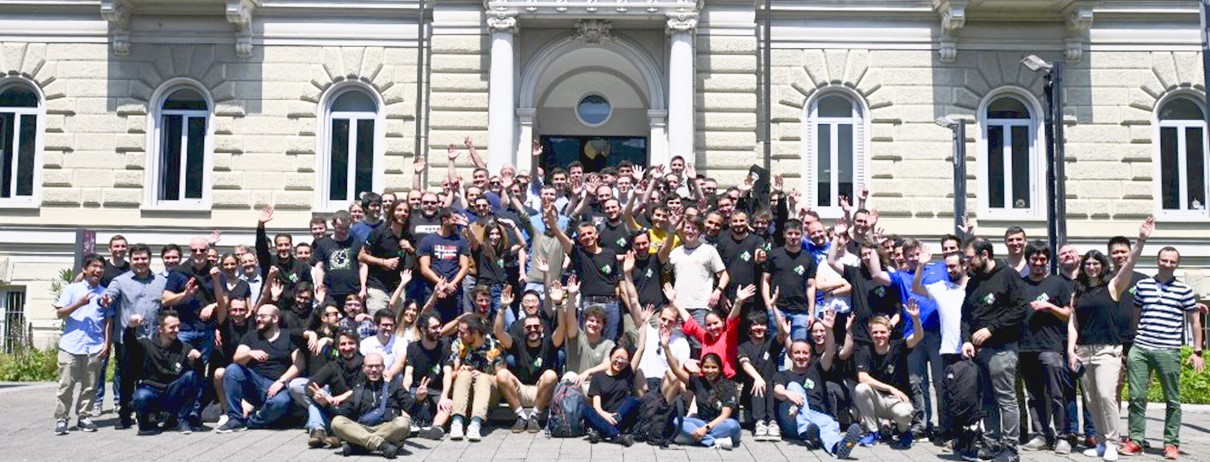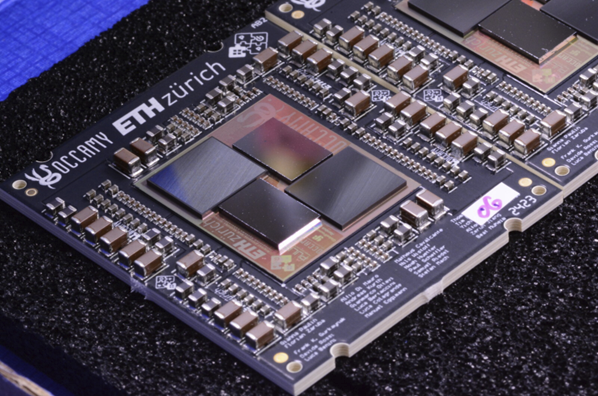"I have always been interested in things that have an impact on society"
Prof. Luca Benini holds the chair of digital circuits and systems at the Integrated Systems Laboratory (IIS). In the interview he talks about the trends towards open-source hardware architecture, new technologies, such as 3D integration, and fruitful collaborations within ETH.
Prof. Benini, what is your area of research?
The focus of my research is in the field of digital circuits and systems. I primarily work on developing chips, which are not only used for powerful computers in data centres (for cloud services and high performance computing), but also for embedded computers, such as those needed to control autonomous vehicles, industrial machines and small devices like smartwatches. These chips are increasingly complex and often associated with artificial intelligence applications, running machine learning models and neural networks to provide faster and better services. A key challenges in this research area is the slowing pace of transistor technology advancement. We need to deliver better performance while keeping power consumption low. This requires innovative architectural design approaches rather than just relying on newer silicon technologies. Additionally, since these chips are used in critical applications like cars and healthcare devices, ensuring their safety, security, and reliability is another critical challenge that we address.
What initially drew you to this field, and what fascinates you about it?
My journey in this field started with a focus on design automation during my doctoral studies. However, as I gained experience, I became more interested in physical chip design and the opportunity to create tangible products. In recent years, what has truly fascinated me is the trend towards open-source computing hardware. It's akin to a revolution in both industry and academia. We are moving away from closed, compartmentalized development and towards more collaborative, open approaches, similar to what happened in the world of open-source software. This shift greatly excites me as it changes how we conduct research and development on digital circuits and systems.

“In recent years, what has truly fascinated me is the trend towards open-source hardware architecture. It's akin to a revolution in both industry and academia. We are moving away from closed, compartmentalized development and towards more collaborative, open approaches.”Prof. Luca Benini
Was it always your intention to become an engineer, or did you consider other career paths?
My parents were both teachers, so academia was a part of my background. However, I was always drawn to subjects that had a physical impact on society, where complex concepts in physics and mathematics intersected with real-world applications. Initially, I contemplated becoming a mathematician or physicist, but I eventually chose engineering because it allows for a more direct and practical impact on society. Engineering lets us create things that are tangible and have an immediate effect on people's lives.
How does your research impact society, and what do you see as the future implications?
Our research on chip design has always had a societal impact, as embedded electronics have become ubiquitous. However, with the rise of artificial intelligence, we're at the cusp of a major transformation. AI is increasingly integrated into our daily lives through autonomous systems, and this trend will likely continue to accelerate. In the next decade, we'll rely even more on electronic systems for various functions. While this can be exciting, it also raises ethical considerations. We need to ensure that our work not only adds fun but also addresses crucial aspects like people's health, safety, and security.
Do you believe that Moore's Law is still valid, or has it plateaued?
Moore's Law is a topic that often gets discussed. From a marketing perspective, it might seem like it's still valid, but the traditional interpretation of Moore's Law, which involved shrinking transistors every 18 months or so, has indeed plateaued several years ago. However, this doesn't mean that progress has halted. Instead, we're seeing innovation in different directions. For example, 3D integration, stacking silicon devices, promises to extend scaling for another decade. We'll need to adapt by learning how to design for these new technologies.
What courses are you teaching next semester?
In the upcoming semester, my group focuses on teaching a series of VLSI (Very Large Scale Integration) classes, with one of them being taught by my colleague, Christoph Studer. Our primary aim in these courses is to instill a strong foundation in chip design among our students. More than just theoretical knowledge, we strive to cultivate practical skills so that when our students complete this sequence, they emerge as accomplished chip designers. In addition, I also teach an advanced class which focuses on equipping students with the knowledge to scale their concepts to larger and more complex systems, providing insights into how leading companies design their own systems. Increasing enrollment numbers in our VLSI classes indicate both the demand for our courses and the effectiveness of our teaching approach. We also observe a growing interest in chip design from students in other disciplines, such as computer science, demonstrating the cross-disciplinary appeal of this field.
Furthermore, my team and I are actively involved in supervising P&S projects together with the Center for Project-Based Learning (PBL), and we are collaborating with Michele Magno on teaching the "Machine Learning on Microcontrollers" course, emphasizing the importance of practical engineering education.
ETH Zurich is unique in having a dedicated Microelectronics Design Center (DZ). How did this come about?
The DZ plays a crucial role in offering an exceptional education to D-ITET students in VLSI design. My journey into this field began during my PhD in the United States, where I encountered a similar educational approach. However, over time, many institutions in the US discontinued such programmes due to increasing design complexity and rising access costs. Currently, there is a resurgence of interest in chip design education globally, driven in part by the rapid advancements in AI technology. We receive numerous inquiries about our teaching methods, educational infrastructure, and expertise in chip design, making us one of the leading institutions in this domain.
Are there any collaborations within D-ITET or other departments at ETH Zurich that you find particularly fruitful?
Collaborations enrich our research and enable us to tackle complex problems more effectively. Within D-ITET, I collaborate extensively with a lot of colleagues in different areas of electronics, computer science and bioengineering. At and beyond our department, I work with researchers in the health domain on projects related to advanced electronics for applications like ultrasound and optoelectronics. In the field of high-performance computing, I have a collaboration with the Department of Computer Science. Additionally, we have collaborated with colleagues on quantum computing projects.
Has the size of your research group been a factor in its success?
The size of my research group has always been a topic of consideration. While it's true that smaller groups might be easier to manage, the type of research we conduct often requires larger teams due to the complexity of manufacturing chips with billions of transistors. Having a larger group allows us to tackle real-world problems and offer students a more comprehensive learning experience. We also embrace an open-source philosophy, which has made it easier for students and collaborators to contribute and participate in our work.
How diverse is your research group in terms of gender, cultural, and professional backgrounds?
We're actively working to make our research group more diverse, particularly in terms of gender. We've been successful in attracting more female students, although achieving a perfect gender balance remains challenging. In terms of cultural diversity, we aim to maintain a good mix of nationalities within the group, fostering a global perspective. We have students from various European countries, among them quite a few Swiss Germans and Italians, and also students from China and Brasil, contributing to a rich cultural blend that enhances our research environment.
Are you currently looking for doctoral students to join your group?
I'm always open to exceptional doctoral students. However, I should note that my focus in the coming years will shift towards winding down my academic responsibilities. Nevertheless, I believe in nurturing new talent, and if the right candidate comes along, I'll certainly consider them.
Has the COVID-19 pandemic had a lasting impact on your teaching and research activities?
The pandemic has prompted adjustments in our teaching and research approaches. While virtual learning tools have become more prevalent, we are now making a conscious effort to encourage students to return to in-person classes, as the practical aspects of hands-on learning are vital. It's crucial to strike a balance between virtual and in-person education. Online meetings make communication easy between the different locations in the ET area and the new office spaces in Oerlikon where also a part of my group is based.
How have students reacted to the shift between remote and in-person learning?
Initially, there was resistance to in-person classes after the pandemic-induced shift to remote learning. However, this year, we've observed a change in attitude, with students showing a greater enthusiasm for attending classes in person. It seems that they have realized that the essence of a university lies in the physical space where students and professors come together to exchange ideas, collaborate, and engage in practical learning experiences: Many of the good ideas come when you are chatting in the coffee corner (laughs).


